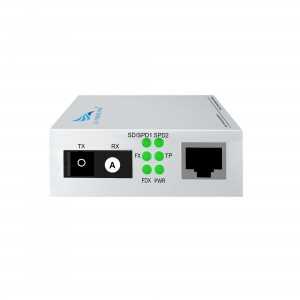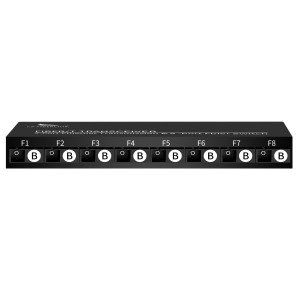9-port 10/100/1000M Media Converter (multi-mode Dual-fiber SC)
9-port 10/100/1000M Media Converter (multi-mode Dual-fiber SC)
Product Features:
Huizhou Changfei Optoelectronics Technology Co., Ltd. launched a revolutionary optoelectronic multi-mode dual-fiber gigabit transceiver and optical converter
At Huizhou Changfei Optoelectronics Technology Co., Ltd., we pride ourselves on delivering cutting-edge solutions to global customers seeking advanced transmission solutions. Our commitment to providing high-quality products and excellent services has earned us the trust and praise of more than 360 distributors and agents in more than 100 countries around the world. With rich research and development experience and a large number of scientific research patents, we continue to innovate the optoelectronic industry.
Our latest innovation combines the functionality of an optical-to-electrical converter and transceiver in one compact device, making it a game-changer for data transmission. With this product, we offer you the best of both worlds. Let us introduce you our outstanding products, 1 optical 8 electrical multimode dual fiber gigabit optical module and 9 ports multimode dual fiber gigabit optical converter.
With nine ports and support for multimode dual-fiber transmission, this product provides unrivaled connectivity for your networking needs. It provides ultra-fast data transfer speeds up to Gigabit, ensuring seamless communication within the network. DC5-12V wide voltage power supply, flexible power supply selection, low power consumption to control energy costs.
This transceiver and fiber optic converter combination is designed to withstand different environmental conditions, supports wide temperature operation, and is suitable for indoor and outdoor use. In addition, the ports are equipped with 4KV lightning protection to protect your network from sudden power surges and ensure uninterrupted performance.
We understand the importance of a user-friendly experience. That’s why our products feature easy-to-configure 4-digit dials, dynamic LED indicators for easy troubleshooting, and plug-and-play setup for easy installation. The SC interface provides a safe and efficient optical connection to ensure reliable data transmission.
Durability is a cornerstone of our product design philosophy. The rugged iron case design ensures longevity and protects internal components from potential damage. Our transceivers and converters are IP30 rated to protect against dust and moisture.
For added convenience, our products are equipped with an external power supply. This not only facilitates flexible placement, but also reduces the burden on the network infrastructure.
To sum up, the 1-optical 8-electric multi-mode dual-fiber gigabit transceiver and 9-port multi-mode dual-fiber gigabit optical converter launched by Huizhou Changfei Optoelectronics Technology Co., Ltd. is a technical miracle that gathers the power of light. and power transmission. With its wide range of features, including high-speed data transmission, lightning protection, user-friendly interface and robust design, it is an ideal solution for maintaining excellent connectivity in different network environments.
Experience the future of data transfer with our revolutionary product. Contact us today and join our global network of satisfied customers who express their satisfaction with the efficiency and reliability of our transmission solutions. Huizhou Changfei Optoelectronics Technology Co., Ltd. is committed to changing the way you connect and transmit data, providing one solution at a time.
What This Product Does
◇ The CF-1028GMW-2 is a media converter designed to convert 1000BASE-X fiber to 1000Base-T copper media or vice versa. Designed under IEEE802.3ab 1000Base-T and IEEE802.3z1000Base-X standards, the CF-1028GMW-2 is designed for use with single-mode fiber cable utilizing the SC-Type connector. The CF-1028GMW-2 supports longwave laser specification at a full wire speed forwarding rate. It works at 1310nm on both transmitting and receiving data.
◇ Other features of this module include the ability to be used as a stand alone device (no chassis required), Auto MDI/MDI-X for TX port, and front panel status LEDs. The CF-1028GMW-2 will transmit at extended fiber optic distances utilizing single-mode fiber up to 2 kilometers.
Other Features
◇ Besides, this media converter can be used as a standalone device (no rack required) or used with CF FIBERLINK’s CF-2U14 rack for auto MDI/MDI-X in TX port in which duplex mode is automatically negotiated.
technical parameter:
| Model | CF-1028GMW-2 | |
| Interface Characteristics | ||
|
Fixed Port |
8* 10/ 100/ 1000Base-T RJ45 port
1* 1000Base-X uplink SC fiber port |
|
| Ethernet Port | 10/ 100/ 1000Base-T auto-sensing, full/half duplex MDI/MDI-X self-adaption | |
|
Twisted Pair Transmission |
10BASE-T: Cat3,4,5 UTP(≤100 meter)
100BASE-T: Cat5e or later UTP(≤100 meter) 1000BASE-T : Cat5e or later UTP(≤100 meter) |
|
| Optical Port | The default optical module is multimode dual fiber 2km, SC port | |
| Wavelength/Distance | multimode: 850nm 0~550M,1310nm 0~2KM | |
| Chip Parameter | ||
| Network Protocol | IEEE802.3 10BASE-T, IEEE802.3i 10Base-T,
IEEE802.3u 100Base-TX, IEEE802.3u 100Base-FX, IEEE802.3x IEEE802.3ab 1000Base-T;IEEE802.3z 1000Base-X; |
|
| Forwarding Mode | Store and Forward(Full Wire Speed) | |
| Switching Capacity | 10Gbps | |
| Buffer Memory | 7.44Mpps | |
| MAC | 2K | |
|
LED Indicator |
Fiber | FX(green) |
| Data | 1/2/3/4/5/6/7/8(green) | |
| Power | PWR (green) | |
| Power | ||
| Working Voltage | AC:100-240V | |
| Power Consumption | Standby<1W, Full load<5W | |
| Power Supply | DC:5V/2A industrial power supply | |
| Lightning protection &Certification | ||
| Lightning protection | Lightning protection: 4KV 8/20us, Protection level: IP30 | |
| Certification | CCC;CE mark, commercial; CE/LVD EN60950;FCC Part 15 Class B; RoHS | |
| Physical Parameter | ||
| Operation TEMP | -20~+55°C;5%~90% RH Non condensing | |
| Storage TEMP | -40~+85°C;5%~95% RH Non condensing | |
| Dimension (L*W*H) | 140mm* 80mm*28mm | |
| Installation | Desktop | |
Product Size:
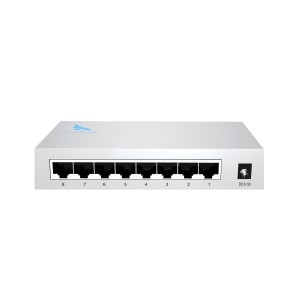
Product application diagra:

How to choose a fiber optic transceiver?
Optical fiber transceivers break the 100-meter limitation of Ethernet cables in data transmission. Relying on high-performance switching chips and large-capacity caches, while truly achieving non-blocking transmission and switching performance, they also provide balanced traffic, isolation and conflict. Error detection and other functions ensure high security and stability during data transmission. Therefore, fiber optic transceiver products will still be an indispensable part of actual network construction for a long time. So, how should we choose fiber optic transceivers?
1. Port function test
Mainly test whether each port can work normally in the duplex state of 10Mbps, 100Mbps and half-duplex state. At the same time, it should be tested whether each port can automatically select the highest transmission speed and automatically match the transmission rate of other devices. This test can be included in other tests.
2. Compatibility test
It mainly tests the connection ability between the optical fiber transceiver and other devices compatible with Ethernet and Fast Ethernet (including network card, HUB, Switch, optical network card, and optical switch). The requirement must be able to support the connection of compatible products.
3. Cable connection characteristics
Test the fiber optic transceiver’s ability to support network cables. First, test the connection ability of Category 5 network cables with lengths of 100m and 10m, and test the connection ability of long Category 5 network cables (120m) of different brands. During the test, the optical port of the transceiver is required to have a connection capability of 10Mbps and a rate of 100Mbps, and the highest must be able to connect to a full-duplex 100Mbps without transmission errors. Category 3 twisted pair cables may not be tested. Subtests can be included in other tests.
4. Transmission characteristics (transmission loss rate of data packets of different lengths, transmission speed)
It mainly tests the packet loss rate when the optical fiber transceiver optical port transmits different data packets, and the connection speed under different connection rates. For the packet loss rate, you can use the test software provided by the network card to test the packet loss rate when the packet size is 64, 512, 1518, 128 (optional) and 1000 (optional) bytes under different connection rates. , the number of packet errors, the number of packets sent and received must be more than 2,000,000. Test transmission speed can use perform3, ping and other software.
5. The compatibility of the whole machine to the transmission network protocol
It mainly tests the compatibility of fiber optic transceivers to network protocols, which can be tested in Novell, Windows and other environments. The following low-level network protocols such as TCP/IP, IPX, NETBIOS, DHCP, etc. must be tested, and the protocols that need to be broadcast must be tested. Optical transceivers are required to support these protocols (VLAN, QOS, COS, etc.).
6. Indicator status test
Test whether the status of the indicator light is consistent with the description of the panel and the user manual, and whether it is consistent with the current status of the fiber optic transceiver.








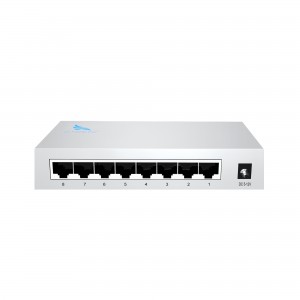
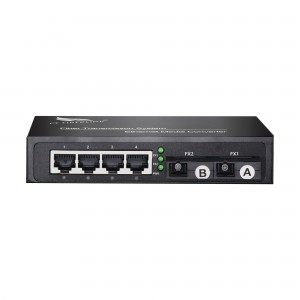
-300x300.jpg)

